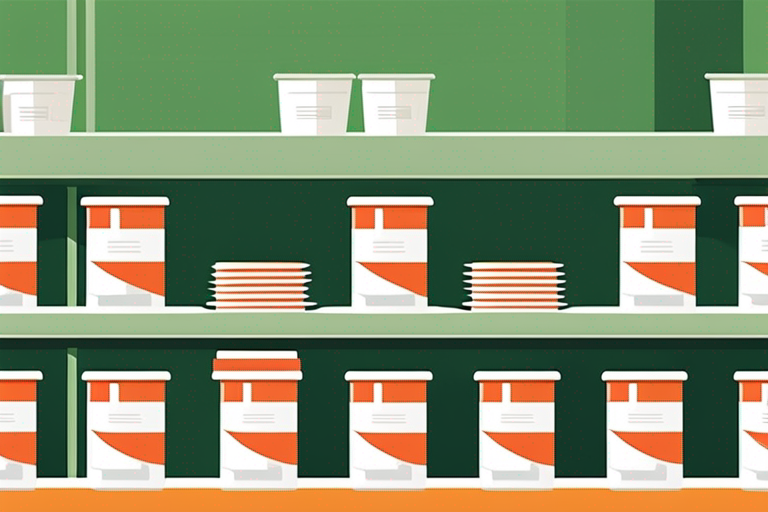
The California Association of Food Banks: Fighting Hunger, Promoting Food Safety
Get Your Free Food Safety Cheat Sheet
30 most common foods with instant answers. Print it and stick it on your fridge—completely free!
The California Association of Food Banks: Fighting Hunger, Promoting Food Safety
In a state as diverse as California, where food abundance and scarcity coexist, the California Association of Food Banks (CAFB) plays a vital role in ensuring that nutritious food reaches those in need. With a network of over 40 food banks serving every county in the state, CAFB works tirelessly to alleviate hunger and food insecurity. In this blog post, we will explore the important work of CAFB, discuss food safety practices within the organization, and provide tips for ensuring food safety in your own home.
The Mission of CAFB
Since its inception, the California Association of Food Banks has been dedicated to addressing food insecurity and hunger in California. Some key points about CAFB include:
History and Background
- CAFB was founded in 1995 to coordinate efforts among food banks across the state.
- The organization collaborates with government agencies, businesses, and community partners to distribute food to those in need.
Programs and Initiatives
- CAFB operates various programs such as Farm to Family, which sources surplus produce from California farms to distribute to food banks.
- The organization also advocates for policies that support food security and nutrition programs at the state and federal levels.
Impact and Reach
- CAFB's network of food banks serves millions of Californians each year, providing essential nutrition to individuals and families facing food insecurity.
- Through innovative initiatives and partnerships, CAFB continues to expand its reach and impact in the fight against hunger.
Food Safety Practices at CAFB
Ensuring food safety is paramount in the operations of CAFB to protect the health of those receiving food assistance. Here are some key points regarding food safety practices at CAFB:
Storage and Handling
- Food banks follow strict protocols for storing and handling perishable and non-perishable food items to prevent contamination and spoilage.
- Temperature-controlled storage areas are utilized to maintain the freshness and safety of food donations.
Inspection and Quality Control
- CAFB conducts regular inspections of donated food items to ensure they meet safety and quality standards.
- Trained staff and volunteers are vigilant in identifying and removing any potentially unsafe or expired products.
Distribution Practices
- CAFB implements best practices in food distribution to minimize the risk of foodborne illnesses.
- Proper labeling and packaging help recipients identify allergens and expiration dates on food items.
Real-Life Scenarios
To better understand the importance of food safety practices, let’s explore some real-life scenarios where these principles come into play.
Scenario 1: A Community Dinner Event
Imagine a community gathering where volunteers prepare meals for local families in need. During the event, one volunteer accidentally uses the same cutting board for raw chicken and a fresh salad. This could lead to cross-contamination, which is a common mistake many people don’t realize can happen so easily. Proper training on food handling can prevent such mishaps, highlighting the need for organizations like CAFB to provide guidance and resources.
Scenario 2: Stocking a Pantry
Consider a family that relies on food assistance from CAFB and receives a box of canned goods. They store these items in their pantry without checking the expiration dates. A few months later, they open a can that has been expired for over a year, leading to health risks. This scenario emphasizes the importance of food safety education, which CAFB provides to recipients to ensure they are aware of how to store and check food items properly.
Scenario 3: Backyard BBQ
During summer, many families participate in barbecues. A family friend brings burgers, but the meat has been sitting in a warm car for hours. They assume it’s still safe to cook. However, unsafe temperatures can allow bacteria like E. coli to thrive. This situation showcases the need for public awareness about the safe transport and storage of food, which CAFB aims to promote through its outreach initiatives.
Scientific Context: Food Safety Practices
Food safety is not just a set of rules but is deeply rooted in science. Understanding foodborne illnesses and their prevention is essential for everyone.
Bacteria and Foodborne Illnesses
Did you know that bacteria can multiply rapidly in the "danger zone," which is the temperature range between 40°F (4°C) and 140°F (60°C)? This is why it's crucial to store perishable items in the refrigerator below 40°F and cook foods to the appropriate internal temperatures (165°F for poultry, for example).
Preservation Methods
Different preservation methods can extend the shelf life of foods and prevent spoilage. Common methods include:
- Canning: A process that uses heat to kill harmful bacteria and seal foods in airtight containers.
- Freezing: Slowing down enzyme activity that causes food to spoil; it's an effective way to preserve freshness.
- Dehydration: This method removes moisture from food, making it less hospitable for bacteria.
One interesting fact is that freezing does not kill bacteria but puts them in a dormant state. This is why thawing and refreezing food can be dangerous if not done properly.
Tips for Ensuring Food Safety at Home
Maintaining food safety practices at home is essential to prevent foodborne illnesses and ensure the well-being of your family. Here are some practical tips you can follow:
- Proper Storage: Store perishable items in the refrigerator at the recommended temperature to prevent spoilage.
- Separate Raw and Cooked Foods: Use separate cutting boards and utensils for raw meats and ready-to-eat foods to avoid cross-contamination.
- Cook Thoroughly: Cook meats, poultry, and seafood to their recommended internal temperatures to kill harmful bacteria.
- Check Expiration Dates: Regularly check the expiration dates of food items in your pantry and discard any that have passed their prime.
- Clean and Sanitize: Wash your hands, kitchen surfaces, and utensils regularly to prevent the spread of germs.
Additional Practical Tips
- Use a Food Thermometer: Invest in a good food thermometer to ensure that your meats reach the designated safe temperatures.
- Plan Your Meals: Create a meal plan to help you use perishable items before they spoil, reducing food waste and saving money.
- Educate Yourself: Familiarize yourself with common foodborne pathogens (like Salmonella, Listeria, and E. coli) and their symptoms to stay informed.
Common Mistakes in Food Safety
Many people unknowingly make mistakes that can compromise food safety at home. Here are some common pitfalls:
- Thawing Food at Room Temperature: This encourages bacterial growth. Instead, thaw foods in the refrigerator, cold water, or the microwave.
- Ignoring Cross-Contamination: Not cleaning surfaces and utensils after preparing raw meats can lead to cross-contamination.
- Overloading the Fridge: Packing your fridge too tightly can block air circulation and prevent consistent cooling. Keep it organized to allow airflow.
Expert Insights: Professional Food Safety Recommendations
As a food safety expert, I recommend adopting a food safety culture in your home. This means making food safety a priority in your routine. Here are some suggestions:
- Regular Training: Just like CAFB staff undergo education on food safety practices, family members should also be educated on basic food handling and safety.
- Create a Food Safety Checklist: Have a list of food safety practices to follow when cooking or storing food. You can hang this checklist in your kitchen for easy reference.
- Communicate: If you’re hosting gatherings, communicate with guests about food allergies and dietary restrictions. Use clear labeling for all food items.
Safety Warnings: Important Cautions and Safety Considerations
While food safety practices can greatly reduce the risk of foodborne illnesses, it's essential to remain vigilant. Here are some critical safety warnings:
- Watch for Signs of Spoilage: If food smells off, has an unusual texture, or shows signs of mold, don’t take any chances—discard it.
- Be Cautious with Canned Goods: If you notice any swelling, leakage, or rusting on the can, it may be a sign of botulism. Do not consume the contents.
- Understand Allergens: Be aware of common allergens in food, such as nuts, dairy, wheat, and soy, and label foods accordingly to prevent allergic reactions.
Conclusion
The California Association of Food Banks plays a crucial role in addressing food insecurity and promoting food safety in the state. By implementing rigorous food safety practices and advocating for policies that support nutrition programs, CAFB continues to make a positive impact on the lives of Californians in need. As individuals, we can also contribute to food safety by following best practices at home and being mindful of how we store, handle, and prepare food. Together, we can work towards a healthier and more food-secure California. Let's be proactive in our approach to food safety, ensuring that everyone has access to safe, nutritious food.

Authoritative Food Safety References
These agencies and university labs inform every tip and health precaution we publish.
USDA FoodKeeper – Cold Storage Guidelines
Official refrigerator, freezer, and pantry timelines maintained by the U.S. Department of Agriculture.
Visit USDA FoodKeeperFDA Produce Safety Rule & Grower Guidance
Field-to-fridge handling practices that prevent contamination of fruits, vegetables, and leafy greens.
Visit FDA Produce SafetyCDC Foodborne Illness Prevention Hub
Surveillance-backed guidance on pathogens, symptoms, and steps to reduce foodborne illness risk.
Visit CDC Food SafetyUC Davis Postharvest Technology Center
University research detailing optimal storage atmospheres for produce after harvest.
Visit UC Davis PostharvestPenn State Extension – Home Food Preservation & Safety
Peer-reviewed extension bulletins on safe canning, chilling, and reheating practices.
Visit Penn State ExtensionWhat is the role of the California Association of Food Banks in fighting hunger?
How can I support the California Association of Food Banks in their mission?
What are some common food safety practices recommended by the California Association of Food Banks?
How does the California Association of Food Banks collaborate with other organizations to address food insecurity?
Get Your Free Food Safety Cheat Sheet
30 most common foods with instant answers. Print it and stick it on your fridge—completely free! Want more? Upgrade to the complete guide with 70+ foods.
Scan your food directly and get instant safety info using our AI-powered camera feature.